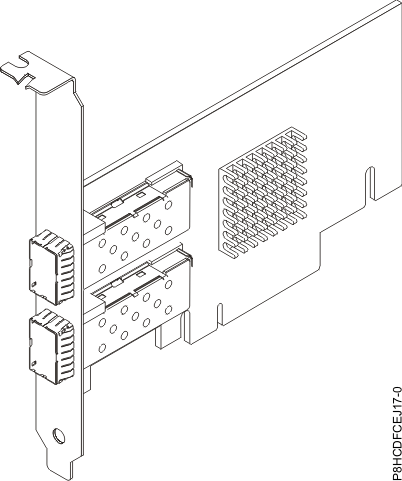PCIe3 CAPI Fibre Channel Flash Accelerator Adapter (FC EJ17)
Learn about the specifications and operating system requirements for the feature code (FC) EJ17 adapter.
Overview
FC EJ16, EJ17, and EJ18 are electronically identical, but have different tailstock brackets.
The PCIe3 LP CAPI Accelerator Adapter (FC EJ17) is a short, full-height, PCI express
(PCIe) generation 3 (Gen3) x8 adapter. This adapter acts as a co-processor for the POWER8® processor, and is designed to offload CPU access to external
Fibre Channel flash storage.
Important: Graphics processing units
(GPUs) and Coherent Accelerator Processor Interface (CAPI) adapters cannot be replaced with the
power turned on.
The adapter provides the following
features:
- The adapter requires a direct-attach, point-to-point 8Gb Fibre Channel link to external storage.
- The adapter includes a programmable CAPI Fibre Channel offload Accelerator Functional Unit (AFU).
- The adapter requires one or more 4096-byte sector logical unit numbers (LUNs) to be provisioned. The adapter and its accompanying software libraries will not function with 512-byte sector LUNs.
- The adapter requires both 3.3 V and 12 V power to be available in the PCIe slot.
- The adapter must be plugged into a direct host-bus PCIe slot to function.
- A maximum of one adapter per processor is supported in the system.
Figure 1. PCIe3 CAPI Fibre Channel Flash Accelerator Adapter

Software requirements
The software requirements
for the FC EJ17 adapter follow:
- The adapter requires that additional software packages for the IBM® Data Engine for NoSQL are installed for CAPI Flash exploitation.
- Software packages and adapter microcode must be installed as a matched pair.
- Software packages are available for download on the Fix Central website under EJ17 feature code.
- Functionality of the adapter is dependent on operating system and software library versions.
- Installation of mismatched adapter microcode and operating system or software libraries results in a log in the Linux system error log. The log will indicate that the firmware needs to be updated.
- AIX 7.2 supports virtual LUN use cases. AIX 7.2, or later is required to fully exploit CAPI Flash functionality such as fine-grained multipathing, multiple LUN support, and persistent storage.
Specifications
- Item
- Description
- Adapter FRU number
- 00NK025 (Designed to comply with RoHS requirement)
- I/O bus architecture
- PCIe3 x16
- Slot requirement
- One CAPI-capable PCIe x16 full height slot.
- Voltage
- 3.3 V and 12 V
- Form factor
- Short, full-height
- Maximum number
For details about slot priorities and placement rules, see PCIe adapter placement rules and slot priorities and select the system you are working on.
Operating system or partition requirements
The adapter is supported on the following versions
of the operating systems, depending on the system you are using:
- AIX®
- AIX 7.2, or later
Create a host in IBM FlashSystem storage
Use this command to create a host in IBM FlashSystem
storage by using Flash World Wide Port Names (WWPN).
Note: To run
this command, you must have AIX 7.2,
or later.
- To create a host in IBM FlashSystem® storage, complete the following steps:
- Log in to the AIX system console as the root user.
- To list all CAPI flash adapters to determine the CAPI Flash World
Wide Port Names (WWPN) for each present accelerator's ports, enter
the following command:
lsdev -C|grep cflash
An output similar to the following example is displayed:
- cflash0 Available 00-4800000 CAPI Flash Adapter (1410f0041410f004)
- cflash1 Available 00-4800001 CAPI Flash Adapter (1410f0041410f004)
- From the output list, select an adapter that uses the name (that
is, cflash0) in the left column. To read the World
Wide Port Names (WWPN) for the first adapter that is listed, enter
the following command:
lscfg -vl cflash0 | grep "Network Address"
An output similar to the following example is displayed:
- Network Address .................. 5005076069800230
- Network Address .................. 5005076069800231
- Find the WWPNs in the output.Note: In the example above, the WWPNs of the adapter are: 5005076069800230 and 5005076069800231.
- Use the WWPNs to create a new host or hosts in the IBM FlashSystem GUI or command-line interface.
- After you create LUNS on the IBM FlashSystem storage, run cfgmgr on
AIX. To view the LUNS, enter the following command:
lsdev -Cc disk |grep CAPI
An output similar to the following example is displayed:
- hdisk1 Available 00-48000000 MPIO CAPI Flash Disk
- hdisk2 Available 00-48000000 MPIO CAPI Flash Disk
- hdisk3 Available 00-48000000 MPIO CAPI Flash Disk
- hdisk4 Available 00-48000000 MPIO CAPI Flash Disk
